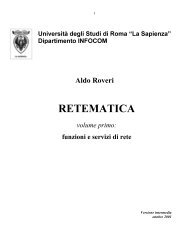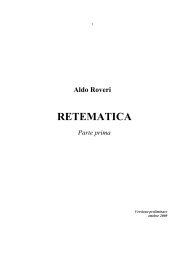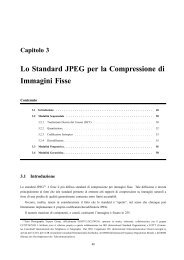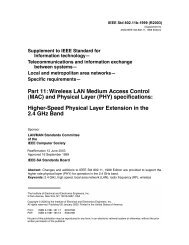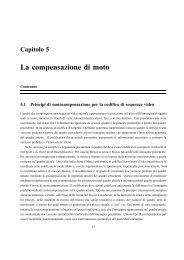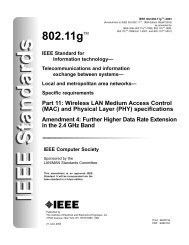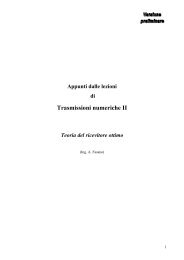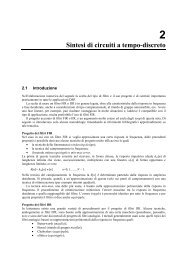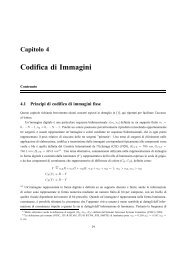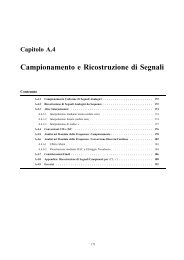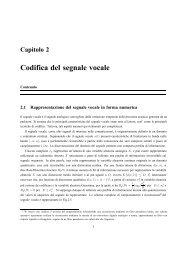a trichromatic colorimeter with spectral primaries - InfoCom
a trichromatic colorimeter with spectral primaries - InfoCom
a trichromatic colorimeter with spectral primaries - InfoCom
Create successful ePaper yourself
Turn your PDF publications into a flip-book with our unique Google optimized e-Paper software.
A TRICHROMATIC COLORIMETER WITH<br />
SPECTRAL PRIMARIES<br />
BY W. D. WRIGHT, A.R.C.S.<br />
MS. received, 19th April, 1928. Read and discussed, 14th June, 1928.<br />
ABSTRACT. The paper describes a <strong>trichromatic</strong> <strong>colorimeter</strong> that has been specially<br />
designed in order to make an accurate re-determination of the locus of the <strong>spectral</strong> colours<br />
in the colour triangle for as many observers as possible. A spectrometer system is used<br />
in which two spectra are formed from the same source. From one of these, three portions<br />
to act as <strong>primaries</strong> are reflected back through a lower part of the dispersing system, so<br />
that the mixing of the three radiations is effected by neutralising the prismatic dispersion<br />
by which the colours were first separated. From the other spectrum the test colour and<br />
a desaturating colour are selected and mixed in a similar manner, and the composite beams<br />
are then brought into the two halves of a simple bipartite field. In the process of being<br />
mixed <strong>with</strong> the other colours, each <strong>spectral</strong> colour is filtered by its return passage through<br />
the dispersing system and the instrument thus becomes very effective in removing stray<br />
light. Another device has enabled the Maxwellian method of observing the field of view<br />
to be adopted <strong>with</strong>out the introduction of rotating parts into the system. The intensities<br />
of the three <strong>primaries</strong> are controlled <strong>with</strong> photometer wedges.<br />
INTRODUCTION<br />
THE <strong>colorimeter</strong> to be described has been designed and made in order to carry<br />
out some researches on colour vision for the Medical Research Council. The<br />
research is being conducted in the Technical Optics Department of the Imperial<br />
College and the particular work in view is the accurate re-determination of the<br />
locus of the <strong>spectral</strong> colours in the colour triangle for as many observers as possible.<br />
In this paper the instrument alone is described; no mention is made of the<br />
method of calculating the results nor of the results themselves. Some preliminary<br />
knowledge of the principles of colorimetry is necessary, however, before the requirements<br />
of a comprehensive <strong>trichromatic</strong> <strong>colorimeter</strong> can be properly understood,<br />
but as these have been clearly outlined in the course of a paper by Mr Guild<br />
in 1926” the reader is referred to that paper for the necessary information. In<br />
that paper it will be seen that what is required for the work in hand is, first, some<br />
arrangement for illuminating one half of a photometric field <strong>with</strong> a mixture of<br />
three primary colours in any desired proportions ; secondly, a method to illuminate<br />
the other half of the field <strong>with</strong> any spectrum colour; and thirdly, to desaturate this<br />
<strong>spectral</strong> colour <strong>with</strong> some other colour (which may be one of the <strong>primaries</strong>) so<br />
that the two together can be matched.<br />
* J. Guild, “A Trichromatic Colorimeter suitable for Standardisation Work,” Trans. Opt. SOC.<br />
27 1925-6 (106).
226<br />
THE OPTICAL SYSTEM OF THE COLORIMETER<br />
The simplest way to explain the principles of the <strong>colorimeter</strong> will be to consider<br />
one or two properties of the ordinary spectrometer system. Such a system is shown<br />
in Fig. I (a). In connection <strong>with</strong> this and subsequent diagrams it must be realised<br />
that no attempt has been made to draw them to scale. To do so would have resulted<br />
in the figures being made so big as to become clumsy if the important details were<br />
to be made at all clear. In Fig. I (U) S is the collimator slit, C the collimating lens,<br />
A the spectrometer prism, T the telescope objective and finally RGB represents<br />
the spectrum formed in the focal plane of T. Three pencils of rays corresponding<br />
to three points, R, G, and B, in the spectrum are shown. These pencils are diverging<br />
from one another but the point of divergence can best be traced by reference to<br />
the enlarged diagram Fig. I (b). This shows part of the course of the central rays<br />
of the three pencils. It will be seen that after refraction at the first surface of the<br />
prism these rays diverge from 0; after refraction at the second surface they radiate<br />
from some point P and after passing through the telescope objective they appear<br />
to diverge from P', where P' is the virtual image of P formed by the objective T.<br />
The position of P' is also indicated in the top diagram Fig. I (a).<br />
Suppose, now, that a concave mirror were placed in the plane of the spectrum<br />
and suppose also that the radius of curvature of the mirror were equal to PIG.<br />
In these circumstances the centre of curvature could be made to coincide <strong>with</strong> P'<br />
and the central rays of all the pencils would then fall normally on to the surface<br />
of the mirror. They would, therefore, be reflected back along their own paths.<br />
In retracing their paths the divergence of the pencils would be neutralised and the<br />
beam would emerge from the first surface of the prism as a parallel bundle of white<br />
light similar to the bundle of light which originally left the collimating lens. There<br />
is an interesting corollary to this, namely, that if the point P were situated at the<br />
focus of T then P' would be at infinity and the central rays would emerge parallel<br />
after passing through the objective. In this case a plane mirror in place of<br />
the concave mirror could be used to reflect the beams back along their own<br />
paths.<br />
So far only the divergence of the beam in the horizontal plane has been con-<br />
sidered ; in this plane the divergence arises from the dispersion produced by the<br />
spectrometer prism. But if a slit is used in the collimator the pencils of light will<br />
also diverge in the vertical plane owing to the length of the slit. Before passing<br />
through T these pencils will radiate from the collimating lens C and after refraction<br />
through T they would appear to diverge from the virtual image of C formed by<br />
the telescope objective. Hence, if it were necessary for the rays of light to retrace<br />
their paths exactly, a different curvature for the mirror would be required in the<br />
vertical plane from that needed in the horizontal plane. In practice such arefinement<br />
is found to be unnecessary.
A Trichromatic Colorimeter <strong>with</strong> Spectral Primaries 227<br />
The next step in the development of the system is to consider the effect of<br />
blocking out parts of the concave mirror. The result will be that some parts of the<br />
spectrum are cut off, whilst others are reflected back to emerge as a parallel beam,<br />
and the colour of the beam will no longer be white but will be the colour resulting<br />
from the mixture of the reflected portions. This, then, provides a method of<br />
Fig. I<br />
separating any portions of the spectrum desired and re-combining them by<br />
neutralising the dispersion by which they were first separated.<br />
It is but a short step from the use of a concave mirror <strong>with</strong> parts blocked out<br />
to the employment of narrow strips of plane mirror mounted on arms which rotate<br />
about P'. Provided that the strips are fairly narrow, the effect of their being plane<br />
instead of concave may be neglected. For the case when P is at the focus of T<br />
and therefore P' at infinity, the strips of mirror would have to move on a straight<br />
slide instead of on the arc of a circle,
228 W. D. Wright<br />
It will be readily realised that to use the system as it has been developed SO<br />
far some difficulty would be experienced in separating the reflected from the<br />
incident beam. Both would traverse the same parts of the prism and objective<br />
and it would be necessary to introduce a parallel plate of glass, possibly half silvered,<br />
into the path of the beams. By inclining this plate at 45" to the direction of the<br />
returning beam, this light would be partially reflected and a separation of the two<br />
beams would be effected. This method would, however, lead to a great loss of light<br />
and, in addition, the surface reflections from the prism faces and the telescope<br />
objective would be mixed up <strong>with</strong> the returning beam, thus introducing stray light.<br />
A more effective method of obtaining the desired result is shown in Fig. 2.<br />
C A T<br />
D<br />
Fig. 2<br />
This diagram shows a vertical section of the system and the path taken by an<br />
axial pencil of light in this plane is indicated. S, C, A, and T refer to the same parts<br />
as in Fig. I. M is a strip of plane mirror and D is a right-angled prism. In the system<br />
shown in this figure it will be noticed that the parallel beam passes through the<br />
upper halves of the spectrometer prism and telescope objective. Further, the<br />
mirror M is arranged, not to reflect the light back on its original path, but to deflect<br />
it downwards, so that on the return journey the light will pass through the lower<br />
halves of the objective and prism. The incident and reflected beams in fact pass<br />
through parts of the objective that are symmetrically placed relative to its axis.<br />
With the arrangement described the 90' prism D can be introduced <strong>with</strong>out in<br />
any way interfering <strong>with</strong> the incident beam and <strong>with</strong> the further advantage that<br />
the whole of the returning beam can be reflected. This method is evidently the<br />
one to be adopted.<br />
In Fig. 3 the system is taken a stage further. The diagram shows a plan view<br />
of the path of an axial pencil of rays. It must be borne in mind that there are really<br />
two layers to the system, the returning beam passing beneath the incident beam.<br />
In this diagram the action of the prism D is shown and the positive lens 0 is intro-<br />
duced. This represents the objective of the observing telescope. In the <strong>colorimeter</strong><br />
itself the photometer prism is placed between D and 0, but for the present that has<br />
been omitted. The Maxwellian method of observing the field of view is used, that<br />
is, the eye is placed at E where the beam of light comes to a focus. The size and<br />
shape of the field seen under these conditions depend on the diaphragm which is<br />
effective in limiting the size of the parallel bundle of light before entering 0.
A Trichromatic Colorimeter <strong>with</strong> Spectral Primaries 229<br />
The image formed at E is that of a slit. This is evident since E and M are in<br />
conjugate planes, as are M and S. Moreover, the image at E will not alter in form,<br />
however much of the spectrum is reflected back; thus, if the concave mirror<br />
originally postulated were placed in the spectrum the image would still be that of<br />
a slit, for it has been shown that the nature of the beam after the dispersion has been<br />
neutralised is exactly similar to the beam when it first emerges from the collimator.<br />
Unfortunately, when the eye is placed at a slit focus the field of view assumes a<br />
streaky appearance. Such an effect renders the field practically useless for accurate<br />
colour matching. What is needed is an exit-pupil of appreciable area in which a small<br />
metal stop can be placed, and be completely filled <strong>with</strong> light. With such an exitpupil<br />
the field of view is smoothed out. This result was obtained in the first place<br />
B 0<br />
Fig. 3<br />
by introducing a wheel of lenses into the system. The effect of this was to spread<br />
out the slit image at E into a band and so provide a satisfactory exit-pupil. Asome-<br />
what more elegant method of reaching this end was, however, thought of, and as<br />
the new scheme was very simple and had several advantages over the rotating lens<br />
system, it was adopted. In place of the narrow strip of plane mirror which was<br />
previously used in the spectrum, a small right-angled prism is mounted <strong>with</strong> its<br />
hypotenuse face facing the incident light. The pencils of light after total reflection<br />
at the two adjacent faces of the prism retrace their paths as before, except that the<br />
light which entered on one side of the prism emerges on the other and vice versa.<br />
The significance of this will be more easily grasped when it is realised that the<br />
principle on which the instrument depends for mixing the <strong>spectral</strong> colours is the<br />
neutralisation of the dispersion by which they are separated. But, for the strip<br />
of the spectrum included by the prism, the relative positions of the <strong>spectral</strong> colours<br />
are reversed so that the dispersion over this strip is no longer neutralised but is<br />
increased.<br />
opt. Soc. XXIX I5
230 W.D. Wr@t<br />
In Fig. 4 (a) three prisms are shown in three parts of the spectrum and it will<br />
be evident that their introduction does not interfere <strong>with</strong> the mixing of the three<br />
separate portions of the spectrum in which they are placed. In Fig. 4 (b) the action<br />
of a single prism is shown and from this it will be seen how the relative positions<br />
of the <strong>spectral</strong> colours are reversed over the portion of the spectrum included by it.<br />
The exit-pupil now takes the form of short superposed strips of spectrum <strong>with</strong><br />
angular dispersions double that pertaining to the corresponding parts of the main<br />
spectrum RGB. When a metal stop is placed in such an exit-pupil, a smooth field<br />
is seen provided the stop is filled <strong>with</strong> light. By using this arrangement any<br />
rotating parts in the apparatus are avoided. In passing it is important to note<br />
that the width of spectrum included in the light reaching the eye depends, not on<br />
the size of the prism in the spectrum, but on the size of the stop in the exit-pupil.<br />
Fig. 4<br />
Up to the present the various features of the system have been described<br />
separately. It is now a relatively simple matter to give a description of the colori-<br />
meter as a whole. In Fig. 5 both plan and elevation of the complete system are<br />
shown, and the course of an axial pencil of rays is also indicated. The source,<br />
condenser, collimator, and spectrometer prisms will be easily recognised ; they are<br />
indicated by the same letters as in previous diagrams. Incidentally, it will be seen<br />
that two 60" prisms are used in order to obtain increased dispersion ; in all there<br />
are four such prisms, two more being used for the returning beam, as will be seen<br />
in the elevation. After passing through these prisms the top half of the beam passes<br />
through the objective Tl and is brought to a focus to form a spectrum at W,. The<br />
lower half of the beam is reflected through an angle of 90' by the prism RI and is<br />
brought to a focus by T, , so producing a second spectrum at W,.<br />
In W, two right-angled prisms are mounted to function as previously described.<br />
The path taken by the light reflected from this spectrum is shown in the elevation<br />
and is seen to pass below RI and above another prism, R, , similar to Rl. In W, there<br />
are three small prisms to reflect back three portions of the spectrum. The light so
A Trichromatic Colorimeter <strong>with</strong> Spectral Primaries 231<br />
reflected passes through T, and is then reflected by R, through the two lower 60"<br />
prisms. The two returning beams, from W, and W,, are.then reflected by D,<br />
so as to fall on the photometer prism P. The form of P and its action will be clear<br />
from the figure. It consists of two prisms cemented together, <strong>with</strong> one half of the<br />
contact surface, mn, silvered. In this way the two beams are brought into the<br />
neighbouring parts of a simple bipartite field separated by a sharp horizontal<br />
T. Fig. 5<br />
dividing line, the size of the complete beam being limited by the rectangular<br />
aperture K. The field of view is observed by placing the eye at the focus E of the<br />
telescope objective 0.<br />
It will be evident that the three prisms at W, correspond to the three <strong>primaries</strong><br />
of the <strong>colorimeter</strong>, and the two prisms at W, provide the test colour and the de-<br />
saturating colour. It is necessary to be able to regulate the intensity of the two<br />
latter and this is done by the use of any one of a series of neutral filters placed<br />
in front of the prisms. Since the variation of the intensity of the <strong>primaries</strong> must<br />
be continuous, neutral photometer wedges, H, are employed, as indicated in the<br />
diagram. These are situated in front of the three primary prisms R, G, and B in<br />
the spectrum at W, and can be adjusted by the observer as explained later.
232 W.D. Wrght<br />
THE DESIGN OF THE APPARATUS<br />
The source of light used is a 100 C.P. Ediswan “Pointolite” lamp. In the<br />
circuit for this lamp a variable resistance and a voltmeter are included SO that,<br />
during any series of results, the lamp can be run at a constant voltage. The slit of<br />
the collimator opens symmetrically, so that a change in its width will not alter the<br />
wave-length calibration of the spectrum.<br />
Fig. 6 is a photograph of part of the apparatus. In this the spectrometer prisms<br />
and the telescope objectives can be seen, also the two prisms R, and R, of Fig. 5.<br />
The objectives have a focal length of about 45 inches and <strong>with</strong> them a spectrum<br />
roughly 9 inches long is obtained. Fig. 7 shows the mounting of the small prisms<br />
in the spectrum W,. With this mounting a tilting or rotatory adjustment can be<br />
given to the prisms and, since the stands are geometric, the prisms can be removed
A Trichromatic Colorimeter <strong>with</strong> Spectral Primaries<br />
23 3<br />
and replaced later <strong>with</strong>out needing any readjustment. The base-plate of each<br />
mounting is attached to a wooden beam about 5 feet in length. One end is pivoted<br />
about a point corresponding to P’ of Fig. I. The pivot consists of a large steel ball<br />
resting between two conical bearings and the beam is thus allowed to rotate about<br />
any axis passing through the centre of the ball. At the other end of the beam two<br />
small steel balls are mounted beneath a wooden cross-piece and are allowed to rest<br />
on a horizontal surface. In these circumstances the movement of the beam is<br />
restricted to a rotation about a vertical axis passing through the centre of the steel<br />
ball, which is the required degree of freedom.<br />
The prism mountings in W, are similar to the above, but there are some ad-<br />
ditional features which differ in the two spectra. The mountings in W, are provided<br />
<strong>with</strong> slots so that any filter that may be desired can be placed in the path of the<br />
beam; further, a scale and pointer are arranged for each of these arms in order that<br />
the positions of the prisms in the spectrum may be calibrated and subsequently<br />
set at any desired wave-length. On the other hand, no wave-length scale is pro-<br />
vided for the <strong>primaries</strong>, but fine adjustment clamps have been fitted to enable the<br />
prisms to be accurately set and clamped in the desired part of the spectrum. These<br />
clamps act in very much the same way as the tangent screw of the ordinary spectro-<br />
meter and are designed so that they do not upset the geometric principles used in<br />
mounting the radial arms.<br />
Fig. 8 shows the mounting of one of the photometer wedges. The wedges are
234 w. D. Wright<br />
inserted in rectangular brass fittings suspended from pulleys pivoted at the tops<br />
of three aluminium pillars. These pillars are screwed down to the radial arms<br />
immediately in front of the prism mountings. Each pillar is arranged to slope<br />
forward slightly so that the wedge mounting rests against its inclined face and will<br />
slide up or down when the string is moved. Guides are provided to keep the wedges<br />
in the proper vertical line and each mounting has a scale and pointer engraved on<br />
it to register the position of the wedge at any setting. To move the wedges the<br />
strings are led via further pulleys to three drums mounted in front of the observer.<br />
The strings are wound round the drums in one direction, whilst in the other direc-<br />
tion are wound strings attached to counter-weights. In this way the weight of each<br />
wedge mounting is balanced and the only forces to be overcome to move the wedges<br />
are frictional forces, which are quite small. If the movement of the drums is too easy,<br />
the bearings of the drum spindles may be tiihtened. In this way a nice motion of<br />
the drums, which is very necessary to ensure the peace of mind of the observer,<br />
can be obtained. To each drum a knurled head is fixed and the position of the three<br />
heads is such that both hands can be used in adjusting them. This is advantageous<br />
and tends to shorten the time required to make a match. The positions of the drums<br />
and the observing telescope are shown in Fig. 9.<br />
The telescope has an objective of focal length about 11 inches and the stop in<br />
the focus consists of a circular hole in a brass disc. Various stops are available,<br />
the one at present in use having a diameter of -033 inch. With this stop the width<br />
of spectrum included is so060 p in the red, -0035 p in the green, and -0016 p<br />
in the blue. The mounting of the telescope is such?that the direction of its axis can<br />
be altered until the stop is filled <strong>with</strong> light. The type of adjustment provided is<br />
evident from Fig. 9.<br />
The size of the photometric field is Q inch square and this subtends an angle
A Trichromatic Colorimeter <strong>with</strong> Spectral Primaries 23 5<br />
of about 2’ at the eye; <strong>with</strong> this size of field the image formed on the retina will fall<br />
entirely <strong>with</strong>in the fovea. This avoids complications which might arise owing to<br />
the variation in structure of different parts of the retina and is in accordance <strong>with</strong><br />
suggestions made by Mr Guild on the standard size of field to use in colorimetry”.<br />
The use of a simple bipartite field is desirable, because one of the chief difficulties<br />
in such an apparatus as this is to secure a strictly uniform field. Without such, any<br />
more complicated type of field is bound to lead to confusion and to add to the<br />
difficulties of colour matching.<br />
For certain purposes not discussed in the present paper a white of some known<br />
<strong>spectral</strong> energy distribution is required. A 1000 watt lamp standardised at the<br />
National Physical Laboratory and a filter of two solutions made up in accordance<br />
<strong>with</strong> specifications from the same laboratory were therefore installed, the necessary<br />
apparatus being supplied by Messrs Adam Hilger, Ltd. With this, a magnesium<br />
oxide screen can be illuminated <strong>with</strong> light of an energy distribution similar to that<br />
of a black body radiating at 5000~ K. A small geometric mounting for the<br />
magnesium screen was made so that it could be readily brought into the field of<br />
view when desired.<br />
ADJUSTMENTS<br />
Little need be said of the adjustments which had to be made when the apparatus<br />
was first set up. Much attention had to be paid to the mounting of the various units<br />
relative to one another, otherwise the size of some of the parts, such as the telescope<br />
objectives, would have been undesirably large. Particular reference need only be<br />
made to the location of the centres about which the radial arms rotate. This is really<br />
a matter of small import since the introduction of the prisms into the spectrum,<br />
but when the apparatus was first assembled strips of plane mirror were used. With<br />
this arrangement the centres had to be located accurately and this was done ex-<br />
perimentally by altering the position of the centre until, on moving the arm through<br />
the spectrum, the reflected patch of light seen in the observing telescope <strong>with</strong> the<br />
photometer prism removed remained stationary.<br />
There are certain adjustments which have to be made <strong>with</strong> some regularity,<br />
so that a description of the method adopted to readjust the apparatus when out of<br />
adjustment is given. The test colour prism must first be tilted so as to reflect the<br />
beam back on the proper level in accordance <strong>with</strong> Fig. 5. Apart from securing total<br />
reflection, no rotation of the prism about a vertical axis is necessary, as the light<br />
will automatically take the required path in the horizontal plane. This is one of<br />
the minor advantages of the use of prisms instead of mirrors. The prism which<br />
provides the desaturating colour is now adjusted in the same way.<br />
The next step is to adjust one of the primary prisms so that it has approximately<br />
the required inclination to the vertical. This is followed by tilting and rotating the<br />
large right-angled prism R, (the requisite mechanical devices are provided) until<br />
the images of the primary and test colour prisms coincide at the focus, E, of the<br />
* J. Guild, “A Critical Survey of Modern Developments in the Theory and Techniqueof<br />
Colorimetry and Allied Sciences.” Proc. Opt. Conwention, 1926 (61).
236 W.D. W7kht -<br />
observing telescope. Generally the primary prism will need a further slight tilting<br />
adjustment, but this will not upset the coincidence of the exit-pupils. The other<br />
two primary prisms now only need to be set at the proper inclination to the vertical<br />
to complete the adjustments at this end of the instrument.<br />
At the other end all that remains to be done is to set the prism D so that the<br />
patches of light fall on the photometer prism in the desired position and finally<br />
to adjust and clamp the observing telescope so that the metal stop is completely<br />
filled <strong>with</strong> light in the desired part of the exit-pupil.<br />
CALIBRATION<br />
To calibrate the " test colour " spectrum, a Hilger I' constant deviation spectro-<br />
meter" is mounted at the observing end of the instrument <strong>with</strong> the ordinary slit<br />
attachment removed and replaced, by suitable disposition of the spectrometer, by<br />
the exit-pupil of the <strong>colorimeter</strong> itself. On looking into the eyepiece of the<br />
spectrometer an elliptical image of the exit-pupil is seen. The position of this image<br />
depends on the wave-length of the light of which it is composed, but by rotating<br />
the wave-length drum it can be made to lie symmetrically on the cross-wire in the<br />
eyepiece. Provided the drum reading for sodium light has been checked, the reading<br />
on the drum will give the mean wave-length corresponding to a given position of the<br />
radial arm in the spectrum. To check the drum reading the exit-pupil must be<br />
filled <strong>with</strong> sodium light; this can be done by placing a sodium flame in the orange<br />
part of the spectrum. Then when the cross-wire is set on the image of the exit-<br />
pupil, the reading of the drum should correspond to the mean sodium line ; if any<br />
error exists it must be removed by adjusting the Hilger spectrometer prism. When<br />
this check has been made the calibration is only a question of noting the drum<br />
readings for given positions of the prism on the spectrum scale.<br />
When the calibration has been made as above, throughout the spectrum, a<br />
further check is performed. The Hilger spectrometer is removed and the slit of the<br />
<strong>colorimeter</strong> is illuminated <strong>with</strong> some source such as a mercury lamp, which gives<br />
a few well-defined <strong>spectral</strong> lines. If the test-colour prism is moved through the<br />
spectrum until the light from one of the lines is reflected back, an image of the line<br />
will be formed at the focus of the observing telescope. The position of the prism<br />
is noted when this image passes through the middle of the exit-pupil. The reading<br />
of the test-colour scale then corresponds to the wave-length of the <strong>spectral</strong> line<br />
being used, so that an accurate check on the calibration can be obtained very readily.<br />
The actual accuracy obtainable in setting the prism is about '0002 p, which corre-<br />
sponds to about 1/10 mm. on the scale.<br />
To fix the primary prisms the wave-lengths that are to be used for the <strong>primaries</strong><br />
must first be decided. When this has been done the Hilger spectrometer is set up<br />
as before and at the same time the test-colour prism is put at the wave-length of<br />
whichever of the <strong>primaries</strong> is being adjusted. The position for this is known, of<br />
course, from the earlier calibration. With the apparatus so set up two ellipses are<br />
seen in the eyepiece of the spectrometer, one corresponding to the test-colour prism<br />
.
A Trichromatic Colorimeter <strong>with</strong> Spectral Primaries 23 7<br />
and one to the primary. Then all that needs to be done is to move the arm of the<br />
primary until the two ellipses coincide and to clamp the arm in that position. The<br />
final setting and clamping is done <strong>with</strong> the fine adjustment attachments. The other<br />
two <strong>primaries</strong> are fixed in a similar manner.<br />
, It has been mentioned in the introduction to this paper that the desaturating<br />
colour may be one of the <strong>primaries</strong>, if desired. In practice it greatly simplifies the<br />
work to make use of this fact, as an intensity match instead of an auxiliary colour<br />
match is all the work that is involved in measuring the desaturating colour intro-<br />
duced. In this case the only calibration needed for the desaturating prism is the<br />
determination of the positions of the primary wave-lengths on its wave-length scale.<br />
To do this, a method similar to that used for the <strong>primaries</strong> themselves is adopted.<br />
The remaining calibration is that of the photometer wedges. One half of the<br />
field of view is illuminated <strong>with</strong> light from the primary whose wedge is to be cali-<br />
brated and the other by light of the same wave-length from the test-colour prism.<br />
A sector <strong>with</strong> a variable aperture is placed in the path of the first of these beams<br />
so that its intensity may be varied by known amounts, and a filter is placed in front<br />
of the test-colour prism to control the intensity of the other half of the field. The<br />
two fields are then matched for a series of sector openings, by adjusting the photo-<br />
meter wedge. In this way the wedge may be calibrated over the portion used in<br />
making such a series of matches. To calibrate another portion of the wedge a<br />
new filter is placed in front of the test-colour prism and matches are again made for<br />
the same series of sector openings. To enable a continuous calibration curve to<br />
be drawn the filters are so chosen that the calibrated portions of the wedge overlap,<br />
six or seven steps usually being sufficient for the complete calibration of a wedge.<br />
The wedges at present in use are of the gelatine on glass type, as supplied by<br />
Messrs Ilford Ltd.; they have a density range of I*, but as the light passes through<br />
them twice the range on the instrument is 3. This is over a length of 6 inches. As<br />
the density at the thick end of the wedge is insufficient to cut out the light completely,<br />
at least for the red and green <strong>primaries</strong>, an auxiliary filter is placed in the paths of<br />
these beams when the amount required in the match is very small. This filter has<br />
to be calibrated when used, but this is very simple, two intensity matches, <strong>with</strong> and<br />
<strong>with</strong>out the filter, being all that is necessary. Small geometric mountings are<br />
provided to hold the filters.<br />
STRAY LIGHT<br />
A vital point in an instrument of the present kind, if the results obtained are<br />
to be reliable, is that errors due to stray light must be avoided. To achieve this <strong>with</strong><br />
any success <strong>with</strong> an ordinary piece of apparatus is difficult, but in this case the<br />
colours of low intensity, such as the blue, have to be quite free from stray light<br />
although the system is being illuminated <strong>with</strong> light of much higher intensity from<br />
the middle part of the spectrum. The methods employed to overcome the difficulties<br />
involved are described in the present section, the extreme importance of the subject<br />
being sufticient justification for devoting a separate section to their description.
238<br />
W. D. Wrght<br />
At first sight it might appear that the type of <strong>colorimeter</strong> that has been described<br />
is especially susceptible to errors from this cause, for the following reason.<br />
Some of the light forming the spectrum is intercepted by the small prisms, but<br />
the majority passes on until, sooner or later, it falls on one surface or another, and<br />
this surface will scatter the light in various directions and may thus be a serious<br />
source of stray light. Suppose, for the purposes of the discussion, that a white<br />
card were placed in the focussed plane of the spectrum, The light would be<br />
scattered in all directions and some of it would return through the instrument and<br />
would evidently be brought to a slit focus in the exit-pupil. Fig. IO shows the<br />
rectangular exit-pupil that is obtained <strong>with</strong> the<br />
prism in the spectrum. Bearing in mind that r""""" f""""': I<br />
this is an image of the prism, it is fairly evident 1<br />
I<br />
I<br />
that the slit exit-pupil obtained <strong>with</strong> the card 1<br />
I<br />
will fall on the middle line of the prism image.<br />
I<br />
Hence if the metal stop were placed symmetri- 1<br />
01 cally in the exit-pupil, the stray light from this 1 I c-,,..,,,-,.. J--,------..-l<br />
I<br />
i<br />
:<br />
source would be included and would invalidate<br />
Fig. IO<br />
the results. If, on the other hand, the stop<br />
were placed on one side, as indicated by the circle in the diagram, this stray light<br />
would be cut out and no longer reach the eye. This then is the first precaution that<br />
is taken in adjusting the instrument.<br />
Even <strong>with</strong> this precaution some light from the card might be scattered by dust<br />
particles, etc., thus introducing stray light of a second order, which might be of<br />
sufficient magnitude to affect the results were the white card placed in the spectrum<br />
as postulated above. In practice, of course, it is arranged that the light falls on<br />
surfaces which are least likely to scatter light back through the system. Thus where<br />
glass surfaces, such as the photometer wedge faces, intervene, they are tilted so<br />
that the surface reflections are not directed towards the instrument. Other surfaces<br />
on which the light falls are blackened. A further important feature which is<br />
responsible for the freedom of the instrument from stray light is that the returning<br />
beam passes through a part of the apparatus which is not used by the incident<br />
light. Were this not possible the apparatus would almost certainly be a failure.<br />
Finally it should be pointed out that the presence or absence of stray light from the<br />
above causes can be definitely tested for. All that has to be done is to remove all<br />
five prism mountings from the radial arms and examine the field of view for stray<br />
light. In making such an examination the eye should be dark adapted, else small<br />
quantities of light will easily pass unnoticed. This test has been carried out on several<br />
occasions and it is a most satisfactory feature of the instrument that no stray light<br />
can be detected in this way.<br />
Unfortunately this does not prove that stray light from all sources is absent,<br />
for it may well happen, in fact it almost certainly must happen, that the monochromatic<br />
light which falls on the prisms in the spectrum will have some scattered<br />
light of other wave-lengths mixed <strong>with</strong> it. But for one fact this might be a source<br />
of error difficult to remove. The saving feature can be understood by considering
A Trichromatic Colorimeter <strong>with</strong> Spectral Primaries 239<br />
the course taken by a pencil of white light reflected back from the spectrum. On<br />
passing through the spectrometer prisms this pencil will be dispersed and in the<br />
plane of the exit-pupil a spectrum will be focussed. But owing to the dispersion,<br />
the stray light admitted by the exit-pupil will be of the same wave-length as the<br />
monochromatic light which is intentionally reflected back and will thus in no way<br />
affect the results. In effect the optical system, besides mixing the various mono-<br />
chromatic beams, also acts as a filter to purify each individual beam. This is an<br />
extremely useful property of the instrument, although quite accidental so far as<br />
the author is concerned. No method has been evolved of testing its effectiveness<br />
directly, but it cannot be open to much doubt.<br />
One further precaution has been taken, which may be understood by reference<br />
to Fig. IO again. In this it is seen that the metal stop was placed unsymmetrically<br />
Fig. II<br />
A F<br />
in the patch of light forming the exit-pupil. If the colour in the two halves were<br />
appreciably different, any light scattered from the unused portion would tend to<br />
upset the results; to prevent this happening a system of diaphragming would be<br />
required which would cut out one half of the exit-pupil. The method adopted is<br />
not ideal, but has proved satisfactory; it is shown in Fig. I I. This diagram shows<br />
the paths of some of the rays as they enter and leave one of the small prisms in the<br />
spectrum. It is evident that if one half of the prism were blocked out, then the whole<br />
beam would be cut off; but <strong>with</strong> the diaphragm in the position shown, where the<br />
incident and reflected beams no longer overlap in the vertical plane, it is possible<br />
to cut off one half of the beam <strong>with</strong>out interfering <strong>with</strong> the other. Such a position<br />
is not ideal because the diaphragm is not sharply in focus in the plane of the exit-<br />
pupil. This, however, is largely counteracted by the narrow divergence of the<br />
pencils of light between the spectrum prism and the diaphragm.
240<br />
w. D. Wright<br />
APPLICATIONS OF THE INSTRUMENT<br />
One evident application is as an instrument for research on colour vision. Its<br />
three chief virtues in this connection are the absence of stray light, the high in-<br />
tensity available in the field of view, and the use of <strong>spectral</strong> <strong>primaries</strong> which have<br />
the advantage that they are easily defined physically. It must also be remembered<br />
that in its present form the apparatus is more than a <strong>trichromatic</strong> <strong>colorimeter</strong>, for<br />
it provides both halves of the photometric field.<br />
With these points in mind it may be well to mention some of the problems which<br />
could be tackled <strong>with</strong> such an instrument <strong>with</strong>, in some cases, small modifications<br />
in the design. Thus the hue sensibility curve for a number of observers could be<br />
determined ; a determination of the number of saturation steps between the <strong>spectral</strong><br />
colours and white or what may be called the saturation sensibility curve for the<br />
<strong>spectral</strong> colours could be undertaken ; also an investigation on complementary<br />
colours could be carried out. Besides this, quantitative data on colour blindness,<br />
colour fatigue, and adaptation might be obtained. It is not possible to give an<br />
exhaustive list of problems, but the above shows the scope of the instrument.<br />
So far as the future of the present design in its aspect of a practical <strong>colorimeter</strong><br />
is concerned, the author has insufficient experience of commercial requirements<br />
to voice an authoritative opinion on the subject. One objection would doubtless<br />
be the size of the apparatus. As designed at present the instrument covers a fair<br />
amount of space, but the size could probably be considerably reduced <strong>with</strong>out<br />
increasing the technical difficulties of its manufacture very greatly. The size of<br />
the exit-pupil is probably a more serious objection, for <strong>with</strong> the present diameter of<br />
e 0 3 3 inch the intensity of dark materials seen through the observing telescope is<br />
rather low.<br />
In such a case it is an advantage if the size can be varied by using, say, a small<br />
iris diaphragm, but <strong>with</strong> this system any variation in the size of exit-pupil involves<br />
a change in purity of the <strong>primaries</strong>. Such a procedure would therefore be objec-<br />
tionable. With the original system, in which a wheel of lenses was employed, a<br />
variable exit-pupil could be used and it may be that a satisfactory instrument for<br />
commercial work could be designed on those lines.<br />
Apart from their use in a <strong>colorimeter</strong> the principles involved in the apparatus<br />
may have some use in connection <strong>with</strong> other instruments. For example, a form of<br />
constant deviation spectrometer could be designed; or by using a mirror instead<br />
of a prism in the spectrum any portion of the spectrum could be concentrated into<br />
a slit image; this might be of use in energy problems when the energy present<br />
were small. For any such purposes the instrument would have the advantage of<br />
being free from stray light.<br />
In conclusion I have to acknowledge <strong>with</strong> gratitude my great debt to Professor<br />
L. C. Martin for having on my behalf approached the Medical Research Council,<br />
to whom I am also greatly indebted, <strong>with</strong> a view to securing a grant to enable me<br />
to undertake the research. In addition several features of the apparatus are due
A Trichromatic Colorimeter <strong>with</strong> Spectral Primaries 241<br />
directIy to Prof. Martin and many modifications are the result of his valued help<br />
and advice. Also, my warmest thanks are due to Mr R. H. Colborne, who during<br />
the later stages has given valuable assistance <strong>with</strong> the work that remained to be<br />
done, and, <strong>with</strong> the apparatus completed, has taken an equal share in the observa-<br />
tional part of the work. Lastly I wish to refer to the frequent recourse that has<br />
been had to Mr J. Guild’s papers in the Transactions of this Society and’ in the<br />
Proceedings of the Optical Convention. These have been extremely useful, both on<br />
the theoretical and the practical aspects of the subject, and have undoubtedly<br />
had a modifying influence on the design of the <strong>colorimeter</strong>.<br />
DISCUSSION<br />
Prof, L. C. Martin: I should like to congratulate Mr Wright on the successful<br />
completion of this instrument in the building of which he has shown so much<br />
ability, and also to express my gratification that through the help of the Physio-<br />
logical Optics Committee of the Medical Research Council (and especially of Sir<br />
John Parsons) it has been possible to commence anew the important work of Abney<br />
and Watson in the convenient room which they themselves designed and used.<br />
I look forward <strong>with</strong> hope for results of great interest and value.<br />
Mr J. Guild: The author is to be complimented on the skill and ingenuity <strong>with</strong><br />
which he has attacked the many difficulties involved in the design of apparatus of<br />
this type. There are only two points which I think call for criticism. The first of<br />
these is the use of gelatine wedges to control the intensities. I have used wedges for<br />
this purpose and have found that they require frequent re-calibration owing to<br />
changes which take place in the gelatine. Further, after some time, local irregu-<br />
larities tend to develop and these are very difficult to eliminate by calibration.<br />
This is really the outstanding difficulty in constructing a <strong>colorimeter</strong> <strong>with</strong><br />
<strong>spectral</strong> <strong>primaries</strong> : no really satisfactory method of controlling their intensity has<br />
been evolved. Varying the width or length of the slits, as has been done by some<br />
of the earlier workers, is useless for precise work, while <strong>with</strong> apparatus of any<br />
reasonable size the primary slits are too close together to allow the interposition of<br />
variable rotating sectors in front of each. This makes it necessary to resort to wedges,<br />
<strong>with</strong> the drawbacks just mentioned.<br />
The second point to which criticism may be directed is the use of a fairly wide<br />
slit, or its equivalent, at the observer’s eye. This is immaterial as regards the<br />
<strong>primaries</strong> themselves, but as regards the monochromatic beam of which the colour<br />
is to be measured it is desirable to be able to employ very narrow slits at some parts<br />
of the spectrum to eliminate uncertainty as to the slit width correction for the wave-<br />
length. The author may find when he comes to the actual working out of his <strong>spectral</strong><br />
mixture curves that it is desirable to restrict his slit width and re-introduce the<br />
rotating lens spreader to obtain the desired width of exit-pupil.<br />
Despite these points the instrument should be a very useful research tool, and<br />
the subsequent publication of results obtained <strong>with</strong> it will be awaited <strong>with</strong> interest.
W. D. Wv&ht<br />
242<br />
As a general <strong>colorimeter</strong> for use in industrial laboratories an instrument of this type<br />
has, however, many disadvantages. Many of the adjustments and calibrations<br />
which would have to be made from time to time <strong>with</strong> such an instrument are only<br />
possible in a research laboratory, requiring auxiliary equipment for the standardisation<br />
of wave-length, photometric transmission, etc., which would not be available<br />
in an industrial laboratory. Colorimeters <strong>with</strong> coloured filters as <strong>primaries</strong> have the<br />
advantage that, when once calibrated at a standardising institution, nothing which<br />
can affect the essential constants of the apparatus can possibly go wrong for a very<br />
long time.<br />
Mr R. Kingslake (communicated) : Mr Wright is to be very heartily congratu-<br />
lated on this extraordinarily ingenious <strong>colorimeter</strong>, and particularly on the many neat<br />
devices he has thought of to overcome the various difficulties which he encountered.<br />
I had the privilege of watching the instrument grow in its early stages, but many of<br />
the parts are new. Especial mention should be made of his idea of using small<br />
reflecting prisms instead of bits of flat mirror, to remove the streakiness of the field<br />
and to make accurate rotational adjustment of the little reflectors unnecessary.<br />
I should however like to ask what is the width of these prisms, or rather what length<br />
of spectrum is reflected by them? Surely these bands are too broad to be considered<br />
as providing strictly monochromatic <strong>primaries</strong> ?<br />
The author has very well emphasised the importance of removing stray light,<br />
and some of his methods are extremely ingenious, displaying a very intimate know-<br />
ledge of the underlying action of the whole instrument. Another point which he has<br />
considered very carefully is experimental comfort ; this is of course important in any<br />
research, but especially so in photometric or other critical visual work. I may add<br />
that Mr Wright not only designed all his apparatus but also made much of it him-<br />
self in the College workshop.<br />
In conclusion I must express admiration at the clearness and completeness of<br />
the whole description, <strong>with</strong> the hope that Mr Wright will shortly be able to contri-<br />
bute further papers on the various applications to which he can put the apparatus.<br />
Mr Wright: Mr Guild rightly points out that the gelatine wedges need frequent<br />
re-calibration and whilst this is inconvenient it is a difficulty which has to be over-<br />
come at the expense of a certain amount of time. When permanent local irregu-<br />
larities develop, the wedges will have to be replaced by new ones. The use of black<br />
glass wedges would be an improvement and would be a necessity for instruments<br />
of a more permanent nature than the present one.<br />
With regard to the uncertainty introduced by the use, as the test colour, of a<br />
beam which is not strictly monochromatic, the magnitude of the error will need<br />
investigation and, if greater than can be tolerated, it will either be necessary to de-<br />
termine a correction curve, or eliminate the error by some instrumental modification.<br />
In reply to Mr Kingslake’s query, the size of the prism in the spectrum does<br />
not determine the range of wave-length that is included in the beam entering the<br />
eye; the determining factor is the size of exit-pupil, as is pointed out in the course of<br />
the paper.



